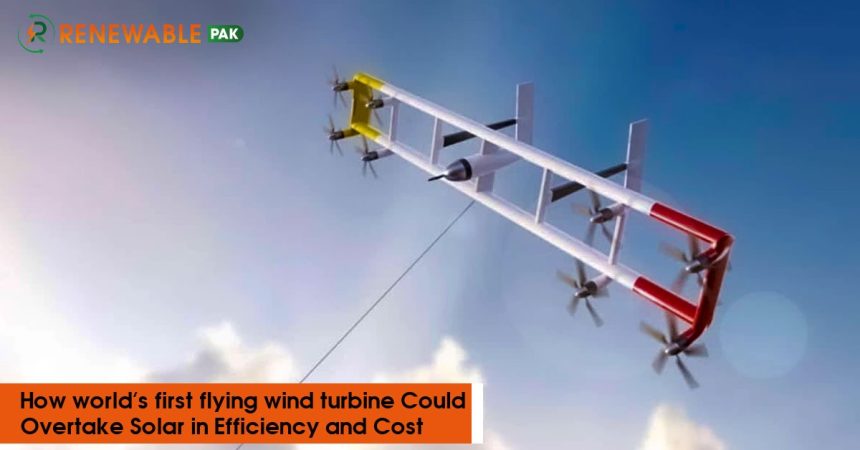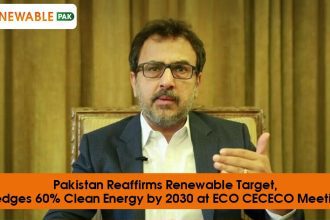What if the future of renewable energy hovered far above us rather than perched atop enormous steel towers or rooftops? The first flying wind turbine in history, created by the German startup KiteKRAFT, promises to do just that. With only a small portion of the materials needed for conventional turbines, this aerial energy solution generates 100 kW of electricity and may be more cost-effective and efficient than solar power.
This invention raises the possibility that the solution to sustainable energy may lie in the skies rather than on the ground as the race to decarbonise heats up.
A Flying Wind Turbine: What Is It?
It’s not science fiction that wind turbines can fly. They are basically kites or gliders that are attached to the ground and have tiny rotors that function similarly to miniature wind turbines. They use the energy from stronger and more reliable winds to power their high-altitude, controlled loops rather than being affixed to a bulky tower.
The ground station receives the electricity they produce and feeds it straight into the grid via the tether. These aerial systems don’t need steel towers, concrete foundations, or expansive infrastructure like traditional wind turbines do.

How KiteKRAFT’s Turbine Works
KiteKRAFT’s prototype looks like a cross between a drone and a small airplane. Its rotors spin in the airflow, while onboard software ensures it flies in precise patterns that maximize power generation.
During testing, a prototype with a 5.5-foot wingspan achieved an output of 100 kW at wind speeds around 20 m/s (approximately 45 mph).
According to KiteKRAFT’s co-founder and CTO, Florian Bauer, the rapid progress is a testament to the potential of airborne wind energy:
“We are proud to have gotten to this point in just over a year since founding the company.” — Florian Bauer, KiteKRAFT
Why Solar Access to High-Altitude Winds May Be Beat by Flying Wind Turbines
Their ability to reach altitudes with stronger and more reliable winds is one of their greatest advantages. The availability of sunlight limits solar panels, while the topography of the area limits ground-based turbines. Flying wind turbines, on the other hand, use a more potent and less fluctuating energy source.
Increased Productivity
High-altitude wind energy studies indicate that, in some circumstances, efficiencies can reach 90%. In contrast, solar panels usually attain 15–22% efficiency, whereas conventional turbines are constrained by Betz’s Law to approximately 59%.
Reduced Prices and Material Consumption
According to KiteKRAFT, its system is half as expensive to construct and uses ten times less material than conventional turbines. Installation and maintenance expenses also drastically decrease in the absence of towers or substantial foundations.
Reduced Footprint
A flying wind turbine is perfect for urban edges, offshore installations, or remote areas because it has a small ground station and requires less land than sprawling solar farms.
Flying wind turbines versus solar
Over the last ten years, solar energy has increased dramatically. The International Energy Agency estimates that between 2018 and 2023, the world’s solar capacity increased by almost 188%. However, wind power continues to produce more electricity globally.
But solar faces significant obstacles:
- Only in the daytime does it produce.
- In cloudy or polluted conditions, efficiency decreases.
- Land-intensive installations frequently face competition from housing or agriculture.
Wind turbines that fly avoid these issues. They have minimal effect on the land below and can function day or night in a variety of settings. In many markets, they could even outperform solar if they are scaled up.
Obstacles and Restrictions
Airborne turbines face obstacles before being widely adopted, despite their potential:
- Airspace Regulation: Aviation clearances are necessary to operate large flying devices, particularly close to populated areas or flight paths.
- Weather Risks: Strong safety measures are necessary because lightning, storms, or abrupt changes in wind could harm systems.
- Durability: These systems need to demonstrate their ability to endure prolonged use in challenging outdoor environments.
- Scaling Up: It takes a substantial financial and engineering investment to go from prototypes to widespread commercial deployment.
Gaining the public’s trust and demonstrating dependability will be crucial, just like with any disruptive technology.
Expert Opinions
Engineers have been captivated by high-altitude wind for many years. Early research indicated great promise:
“A flying generator’s efficiency can reach 90% in some places… at less than 2 cents per kilowatt-hour.” — Studying wind systems in the air
Flying wind turbines could compete with the most affordable renewable energy sources currently on the market if those figures are accurate.
Prospects for the Market
Although flying wind turbines are still in the early stages of development, there are many potential uses for them:
- Remote Areas: Portable aerial systems could be advantageous for communities without grid access.
- Offshore Energy: Turbines could be installed on floating platforms in place of expensive seabed foundations.
- Urban Edges: Small systems could be used as backup energy sources or to power industrial areas.
Gazing Ahead
The flying wind turbine from KiteKRAFT is just the beginning. Airborne wind energy solutions are also being investigated by other startups, such as Kitepower and Altaeros. The competition might hasten innovations and hasten the commercialisation of the idea.
Airborne systems could be a key instrument in the global shift to net-zero energy if they can get past scaling and regulatory obstacles.
In summary
The flying wind turbine is a daring change in the way that renewable energy is thought of. It offers high efficiency, lower costs, and a smaller land footprint by surpassing the constraints of conventional systems.
Airborne wind power has the potential to reshape the clean energy race, even though solar is still the renewable energy source with the fastest rate of growth in the world. What started out as an experimental kite could soon become a common solution, as Florian Bauer suggests.
Solar has long been the victor in the fight for renewable energy, but with the skies now at stake, the future of energy might actually be up in the sky.
References:
https://www.ecoportal.net/en/the-worlds-first-flying-wind-turbine/11861
https://www.wired.com/2005/04/windmills-in-the-sky
https://pvcase.com/blog/solar-vs-wind-energy-which-is-better
https://nrgcleanpower.com/learning-center/solar-energy-vs-wind-energy
Read More About : Wind Farm Efficiency: The Wake Effect – A Hidden Threat












